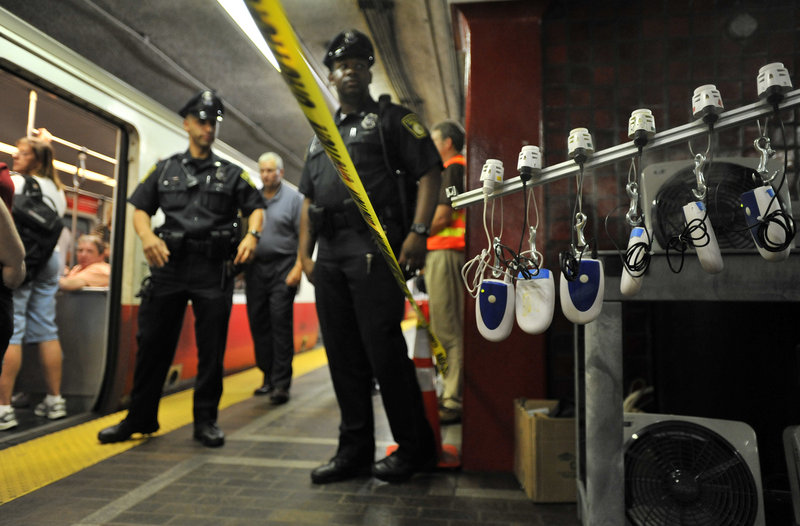BOSTON – Scientists released gases and fluorescent particles into Boston’s subway tunnels on Friday to study how toxic chemicals and lethal biological agents could spread through the nation’s oldest subway system in a terrorist attack.
It’s part of a weeklong study commissioned by the U.S. Department of Homeland Security to figure out ways to quickly minimize the impact of an airborne assault on the nation’s 15 subway systems and protect the nation’s infrastructure. U.S. subway systems include 810 miles of track in tunnels and accounted for about 3.45 billion trips taken last year, according to the American Public Transportation Association.
The scientists are monitoring concentration of the gases — which are invisible to the naked eye and nontoxic — and particles as they move throughout the system and then up into the streets above, pushed by turbulence created by trains thundering through the tunnels. Researchers use electronic devices to take air samples at more than 20 Massachusetts Bay Transportation Authority stations and in subway cars.
Test results will be used to craft ways to quickly detect an attack so authorities can shut down subways to limit the spread of contaminants.
Federal officials say similar tests were conducted in 2008 in the Washington, D.C., area, serving as an excellent contrast to the Boston study. The Massachusetts subway system, which opened its first tunnels in 1897, is poorly ventilated, while Washington’s is relatively modern and well-ventilated, DHS officials said.
Abel Girmai, an aspiring actor from Cambridge who rode Boston’s Red Line on Friday, said he thinks about the possibility of an attack “all the time” and supports studying how a biological attack would play out in the subway system.
“Anything that has to do with security, I’m with it,” Girmai said. “I think at certain times, we do get in a comfort zone. Americans are like that. We don’t think something like that will happen, but we have to get out of that mode.”
Donna Derochers, a legal secretary from Halifax, said she wasn’t thrilled with the idea of the study.
“It’s scary because you are going to find out what could actually happen. You might not want to know,” she said. “You may not want to ride the ‘T’ ever again.”
Though the study focuses on the deliberate release of chemical or biological agents, it also will help researchers understand airflow characteristics for smoke or unintentional spills of chemicals or fuels, DHS said in a statement.
The potency of a chemical or biological attack on underground tunnels was demonstrated in 1995, when a Japanese cult used the deadly sarin nerve gas to attack the Tokyo subway system, killing 12 people and injuring hundreds of others.
In the U.S., authorities thwarted an al-Qaida-sponsored plot of three coordinated suicide bombing attacks on New York City subways last September.
“The MBTA is working closely with our federal partners in order to make the transit system as safe as possible,” MBTA Transit Police Chief Paul MacMillan said.
Copy the Story Link
Send questions/comments to the editors.



Success. Please wait for the page to reload. If the page does not reload within 5 seconds, please refresh the page.
Enter your email and password to access comments.
Hi, to comment on stories you must . This profile is in addition to your subscription and website login.
Already have a commenting profile? .
Invalid username/password.
Please check your email to confirm and complete your registration.
Only subscribers are eligible to post comments. Please subscribe or login first for digital access. Here’s why.
Use the form below to reset your password. When you've submitted your account email, we will send an email with a reset code.